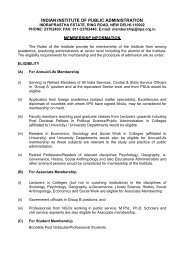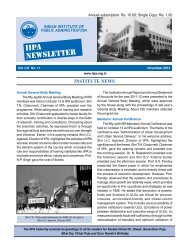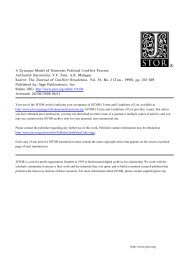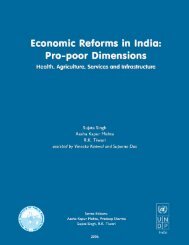Privatisation of Health Care in India - Indian Institute of Public ...
Privatisation of Health Care in India - Indian Institute of Public ...
Privatisation of Health Care in India - Indian Institute of Public ...
- No tags were found...
Create successful ePaper yourself
Turn your PDF publications into a flip-book with our unique Google optimized e-Paper software.
<strong>Privatisation</strong> <strong>of</strong> <strong>Health</strong> <strong>Care</strong> <strong>in</strong> <strong>India</strong>Maharashtra <strong>in</strong>dicate that the middle and better <strong>of</strong>f sections<strong>in</strong> these communities use the services <strong>of</strong> both qualifiedand unqualified private practitioners. The really poorare unable to afford the doctor’s charges and hence, eitheropt for government hospitals or <strong>of</strong>ten go without care(Bisht, 1993; Soman, 1992; Vijaya, 1997; Kakade, 1998).Chemist shops and pharmaceutical representatives <strong>in</strong>fluencethe prescription patterns <strong>of</strong> both qualified and unqualifiedpractitioners. In addition, the former also dispensemedic<strong>in</strong>es for a variety <strong>of</strong> ailments and act as providers <strong>of</strong>primary level care. Studies by Phadke and Greenhalgh <strong>in</strong>Maharashtra have amply demonstrated the nexus betweenthe pharmaceutical <strong>in</strong>dustry’s market<strong>in</strong>g network and prescriptionpatterns <strong>of</strong> doctors, both qualified and unqualified(Greenhalgh, 1987; Phadke, 1998; Shah, 1997). Phadke’sstudy on the supply and use <strong>of</strong> pharmaceuticals <strong>in</strong> Sataradistrict <strong>of</strong> Maharashtra shows that a high proportion <strong>of</strong>prescriptions are irrational and <strong>of</strong>ten very expensive. The<strong>in</strong>fluence <strong>of</strong> pharmaceutical representatives is significant andthey are the s<strong>in</strong>gle most important source <strong>of</strong> cont<strong>in</strong>u<strong>in</strong>gmedical education <strong>of</strong> doctors (Phadke, 1998). While exam<strong>in</strong><strong>in</strong>gthe utilisation <strong>of</strong> health services <strong>in</strong> the Kandhamal district<strong>of</strong> Orissa, it was seen that women utilise the pharmacist’sservices <strong>in</strong> both rural and urban areas without consult<strong>in</strong>ghealth pr<strong>of</strong>essionals (Samantaray, 2000).Given the poor knowledge base <strong>of</strong> these practitioners, itis not surpris<strong>in</strong>g that their treatment <strong>of</strong> even common ailmentsis <strong>of</strong>ten irrational, <strong>in</strong>effective and sometimes harmful.Studies that have analysed provider behaviour withrespect to specific diseases like tuberculosis and diarrhoea<strong>in</strong> Maharashtra, Delhi slums and Tamil Nadu support thef<strong>in</strong>d<strong>in</strong>gs from elsewhere (Uplekar and Shepherd, 1991;Bhandari,1992; Balambal et al, 1997).4.2. Characteristics <strong>of</strong> PrivateProviders at the Secondary andTerertiartiary Levels <strong>of</strong> <strong>Care</strong>A few studies on the secondary level <strong>of</strong> care show that itconsists <strong>of</strong> <strong>in</strong>stitutions with five to over 100 beds that provideboth outpatient and <strong>in</strong>patient services. These studiesprovide an <strong>in</strong>sight <strong>in</strong>to the heterogeneity <strong>of</strong> these <strong>in</strong>stitutions<strong>in</strong> terms <strong>of</strong> scale <strong>of</strong> operation, services <strong>of</strong>fered, technologyemployed and the social background <strong>of</strong> patientsus<strong>in</strong>g these facilities (Bhat, 1993; Jesani and Anantharam,1993; Nanda and Baru, 1993; Baru, 1998; Muraleedharan,1999). They have further shown that s<strong>in</strong>gle owners or partners,who are mostly doctors, usually promote these <strong>in</strong>stitutions.Typically, these <strong>in</strong>stitutions are located <strong>in</strong> towns andcities, but <strong>in</strong> some states like Andhra Pradesh, Maharashtra,Gujarat and parts <strong>of</strong> Karnataka and Tamil Nadu, they havespread to urban peripheries and rural areas especially thosewhich are economically well developed. Given the variability<strong>in</strong> the size and characteristics <strong>of</strong> the <strong>in</strong>stitutions at thislevel <strong>of</strong> care there is much plurality <strong>in</strong> type, quality and cost<strong>of</strong> services provided by such <strong>in</strong>stitutions.Nandraj and others have explored the variability <strong>in</strong> the physical<strong>in</strong>frastructure, qualifications <strong>of</strong> personnel and their practicesat the secondary level <strong>of</strong> care <strong>in</strong> Mumbai. The studies fromDelhi, Chennai and Hyderabad show similar trends and thislack <strong>of</strong> basic and uniform standards for service provision<strong>in</strong>ghas implications for the quality <strong>of</strong> care provided (Baru,1998; Muraleedharan, 1999). It is important to po<strong>in</strong>t outhere that there is a dearth <strong>of</strong> studies, which exam<strong>in</strong>e thequality <strong>of</strong> the private sector <strong>in</strong> some detail.The tertiary level forms only three to five percent <strong>of</strong> thetotal private sector and is located <strong>in</strong> larger cities. Typicallythese are promoted as trusts, public or private limited enterprisesand most are located <strong>in</strong> the southern cities <strong>of</strong> Chennai,Bangalore and Hyderabad. These hospitals have a strongNRI l<strong>in</strong>k and provide a range <strong>of</strong> super specialist care.4.3. Regional Variations <strong>in</strong> theGrowth <strong>of</strong> Private <strong>Health</strong> <strong>Care</strong>The growth <strong>of</strong> the private sector is related to the level <strong>of</strong>economic and <strong>in</strong>frastructure development. As mentioned<strong>in</strong> the earlier section, the primary level <strong>of</strong> care consist<strong>in</strong>g<strong>of</strong> private practitioners is widespread <strong>in</strong> both rural/urbanareas and across states. However, when it comes to secondaryand tertiary levels <strong>of</strong> care there is a dist<strong>in</strong>ct variationacross states. A study across developed and backward12

















